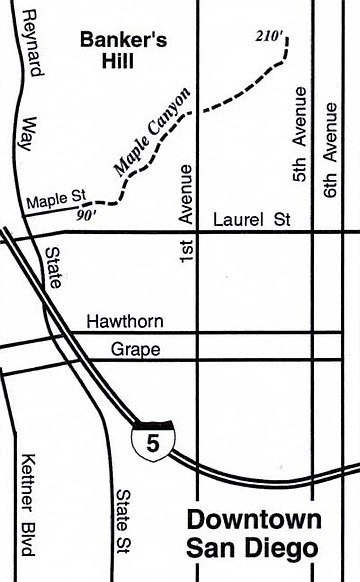 Facebook
Facebook
 X
X
 Instagram
Instagram
 TikTok
TikTok
 Youtube
Youtube
San Diego's picturesque "canyons" -- the narrow ravines slashing into the city's elevated plateaus ("mesas") that overlook the bay and the ocean -- number in the dozens. The so-called mesas are actually marine terraces, the remnants of flat topography lying just offshore during intervals of higher sea level that have occurred in the last million years or so. Erosion by flowing water has eaten away at these now-elevated terraces, creating the narrow, steep-sided drainage channels referred to as the urban canyons of San Diego.
Our urban canyons are increasingly recognized as valuable natural resources for plant and wildlife habitat preservation and for public recreation. Several have already been declared as public open-space "parks."
One such canyon lies barely outside the boundary of downtown San Diego, just north of Little Italy. Maple Canyon can most conveniently be entered at the eastern dead end of Maple Street, north of Laurel Street and just east of Reynard Way. Please note that there are multiple, aligned but discontinuous segments of Maple Street stretching eastward for several miles. This particular Maple Street segment ends two blocks east of Reynard Way at a sign indicating Maple Street Open Space Park.
Make your way up the wide, smooth path, noting the mix of native sage-scrub/chaparral vegetation and the non-native eucalyptus trees and palm trees. A particularly invasive member of the non-native group is the bamboo-like giant cane, which has been the target of eradication efforts all over the city.
At about 100 yards into the canyon, notice the steep slope to the right. At the top lies an obscure historical marker commemorating the early (1909) aviation feats of Waldo Waterman, who sailed off this perch on a homemade contraption and glided into the canyon bottom without breaking his neck. The plaque, at the corner of Albatross and Maple, is better suited for a drive-by visit than a side trip on foot.
Proceed farther up the canyon floor, passing under the graceful, 104-foot-high First Avenue bridge, erected under the Improvement Act of 1911. After a total of about one-half mile, you reach the wooden supporting beams of the equally historic Quince Street footbridge. A steep path on the left connects to Third Avenue and houses above, but the easy way back is to simply retrace your steps.


San Diego's picturesque "canyons" -- the narrow ravines slashing into the city's elevated plateaus ("mesas") that overlook the bay and the ocean -- number in the dozens. The so-called mesas are actually marine terraces, the remnants of flat topography lying just offshore during intervals of higher sea level that have occurred in the last million years or so. Erosion by flowing water has eaten away at these now-elevated terraces, creating the narrow, steep-sided drainage channels referred to as the urban canyons of San Diego.
Our urban canyons are increasingly recognized as valuable natural resources for plant and wildlife habitat preservation and for public recreation. Several have already been declared as public open-space "parks."
One such canyon lies barely outside the boundary of downtown San Diego, just north of Little Italy. Maple Canyon can most conveniently be entered at the eastern dead end of Maple Street, north of Laurel Street and just east of Reynard Way. Please note that there are multiple, aligned but discontinuous segments of Maple Street stretching eastward for several miles. This particular Maple Street segment ends two blocks east of Reynard Way at a sign indicating Maple Street Open Space Park.
Make your way up the wide, smooth path, noting the mix of native sage-scrub/chaparral vegetation and the non-native eucalyptus trees and palm trees. A particularly invasive member of the non-native group is the bamboo-like giant cane, which has been the target of eradication efforts all over the city.
At about 100 yards into the canyon, notice the steep slope to the right. At the top lies an obscure historical marker commemorating the early (1909) aviation feats of Waldo Waterman, who sailed off this perch on a homemade contraption and glided into the canyon bottom without breaking his neck. The plaque, at the corner of Albatross and Maple, is better suited for a drive-by visit than a side trip on foot.
Proceed farther up the canyon floor, passing under the graceful, 104-foot-high First Avenue bridge, erected under the Improvement Act of 1911. After a total of about one-half mile, you reach the wooden supporting beams of the equally historic Quince Street footbridge. A steep path on the left connects to Third Avenue and houses above, but the easy way back is to simply retrace your steps.
